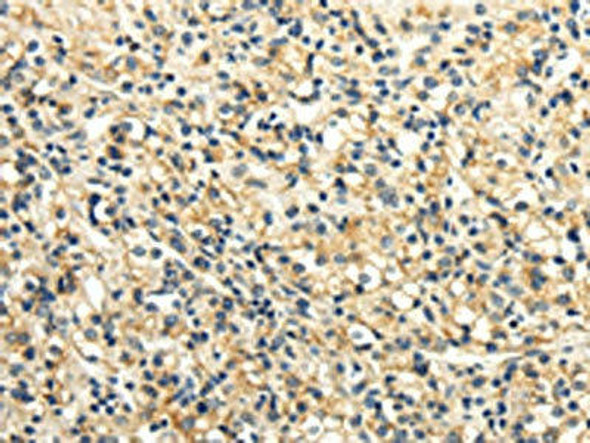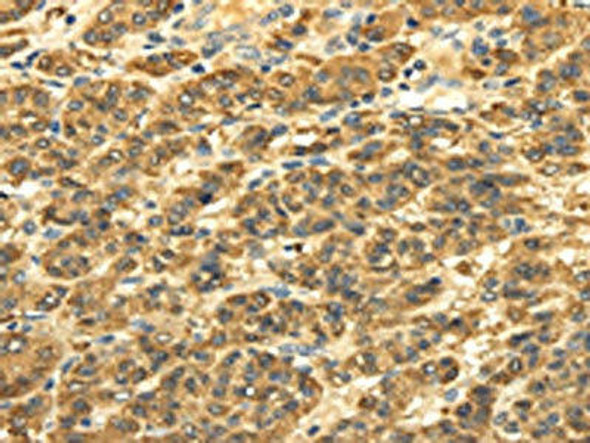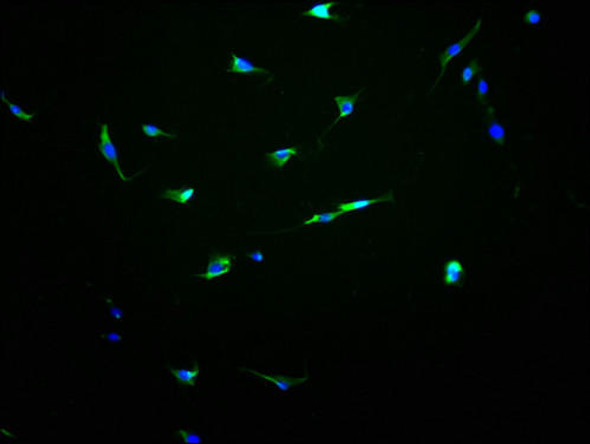Description
| Antibody Name: | SLC6A19 Antibody (PACO60100) |
| Antibody SKU: | PACO60100 |
| Size: | 50ug |
| Host Species: | Rabbit |
| Tested Applications: | ELISA, IHC, IF |
| Recommended Dilutions: | ELISA:1:2000-1:10000, IHC:1:200-1:500, IF:1:50-1:200 |
| Species Reactivity: | Human |
| Immunogen: | Recombinant Human Sodium-dependent neutral amino acid, transporter B(0)AT1 protein (326-413AA) |
| Form: | Liquid |
| Storage Buffer: | Preservative: 0.03% Proclin 300 Constituents: 50% Glycerol, 0.01M PBS, pH 7.4 |
| Purification Method: | >95%, Protein G purified |
| Clonality: | Polyclonal |
| Isotype: | IgG |
| Conjugate: | Non-conjugated |
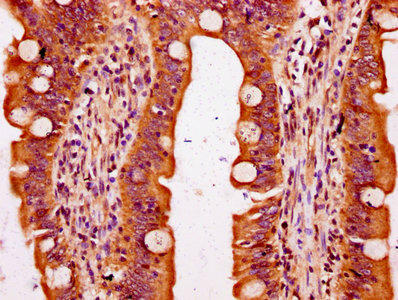 | IHC image of PACO60100 diluted at 1:300 and staining in paraffin-embedded human small intestine tissue performed on a Leica BondTM system. After dewaxing and hydration, antigen retrieval was mediated by high pressure in a citrate buffer (pH 6.0). Section was blocked with 10% normal goat serum 30min at RT. Then primary antibody (1% BSA) was incubated at 4°C overnight. The primary is detected by a biotinylated secondary antibody and visualized using an HRP conjugated SP system. |
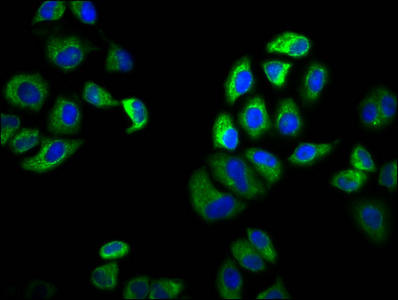 | Immunofluorescence staining of Hela cells with PACO60100 at 1:100, counter-stained with DAPI. The cells were fixed in 4% formaldehyde, permeabilized using 0.2% Triton X-100 and blocked in 10% normal Goat Serum. The cells were then incubated with the antibody overnight at 4°C. The secondary antibody was Alexa Fluor 488-congugated AffiniPure Goat Anti-Rabbit IgG(H+L). |
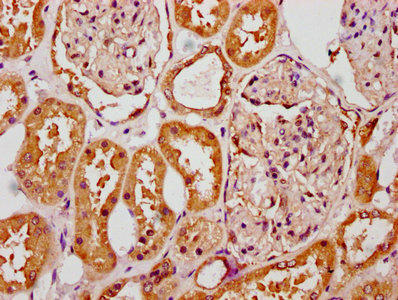 | IHC image of PACO60100 diluted at 1:300 and staining in paraffin-embedded human kidney tissue performed on a Leica BondTM system. After dewaxing and hydration, antigen retrieval was mediated by high pressure in a citrate buffer (pH 6.0). Section was blocked with 10% normal goat serum 30min at RT. Then primary antibody (1% BSA) was incubated at 4°C overnight. The primary is detected by a biotinylated secondary antibody and visualized using an HRP conjugated SP system. |
| Background: | Transporter that mediates resorption of neutral amino acid, across the apical membrane of renal and intestinal epithelial cells. This uptake is sodium-dependent and chloride-independent. |
| Synonyms: | Sodium-dependent neutral amino acid, transporter B(0)AT1 (Solute carrier family 6 member 19) (System B(0) neutral amino acid, transporter AT1), SLC6A19, B0AT1 |
| UniProt Protein Function: | SLC6A19: Transporter that mediates epithelial resorption of neutral amino acids across the apical membrane of epithelial cells in the kidney and intestine. It appears that leucine is the preferred substrate, but all large neutral non-aromatic L-amino acids bind to this transporter. Uptake of leucine is sodium- dependent. In contrast to other members of the neurotransmitter transporter family, does not appear to be chloride-dependent. Defects in SLC6A19 are a cause of Hartnup disorder (HND). HND is an autosomal recessive abnormality of renal and gastrointestinal neutral amino acid transport noted for its clinical variability. First described in 1956, HND is characterized by increases in the urinary and intestinal excretion of neutral amino acids. Individuals with typical Hartnup aminoaciduria may be asymptomatic, some develop a photosensitive pellagra-like rash, attacks of cerebellar ataxia and other neurological or psychiatric features. Although the definition of HND was originally based on clinical and biochemical abnormalities, its marked clinical heterogeneity has led to it being known as a disorder with a consistent pathognomonic neutral hyperaminoaciduria. Defects in SLC6A19 may be a cause of hyperglycinuria (HG). It is a condition characterized by excess of glycine in the urine. In some cases it is associated with renal colic and renal oxalate stones. SLC6A19 deficiency combined with haploinsufficiency of SLC6A20 or partially inactivating mutations in SLC36A2, can be responsible for hyperglycinuria. Defects in SLC6A19 may be a cause of iminoglycinuria (IG). It is a disorder of renal tubular reabsorption of glycine and imino acids (proline and hydroxyproline), marked by excessive levels of all three substances in the urine. SLC6A19 deficiency combined with haploinsufficiency of SLC6A20 or partially inactivating mutations in SLC36A2, can be responsible for iminoglycinuria. Additional polymorphisms and mutations in SLC6A18 can contribute to the IG phenotype in some families. Belongs to the sodium:neurotransmitter symporter (SNF) (TC 2.A.22) family. SLC6A19 subfamily.Protein type: Transporter; Membrane protein, integral; Transporter, SLC family; Membrane protein, multi-passChromosomal Location of Human Ortholog: 5p15.33Cellular Component: integral to plasma membrane; plasma membraneMolecular Function: amino acid transmembrane transporter activity; neutral amino acid transmembrane transporter activityBiological Process: amino acid transportDisease: Hartnup Disorder; Hyperglycinuria; Iminoglycinuria |
| UniProt Protein Details: | |
| NCBI Summary: | This gene encodes a system B(0) transmembrane protein that actively transports most neutral amino acids across the apical membrane of epithelial cells. Mutations in this gene result in Hartnup disorder. [provided by RefSeq, Jul 2008] |
| UniProt Code: | Q695T7 |
| NCBI GenInfo Identifier: | 73919285 |
| NCBI Gene ID: | 340024 |
| NCBI Accession: | Q695T7.1 |
| UniProt Secondary Accession: | Q695T7,A8K446 |
| UniProt Related Accession: | Q695T7 |
| Molecular Weight: | 71,110 Da |
| NCBI Full Name: | Sodium-dependent neutral amino acid transporter B(0)AT1 |
| NCBI Synonym Full Names: | solute carrier family 6 member 19 |
| NCBI Official Symbol: | SLC6A19 |
| NCBI Official Synonym Symbols: | HND; B0AT1 |
| NCBI Protein Information: | sodium-dependent neutral amino acid transporter B(0)AT1 |
| UniProt Protein Name: | Sodium-dependent neutral amino acid transporter B(0)AT1 |
| UniProt Synonym Protein Names: | Solute carrier family 6 member 19; System B(0) neutral amino acid transporter AT1 |
| Protein Family: | Sodium-dependent neutral amino acid transporter |
| UniProt Gene Name: | SLC6A19 |
| UniProt Entry Name: | S6A19_HUMAN |


